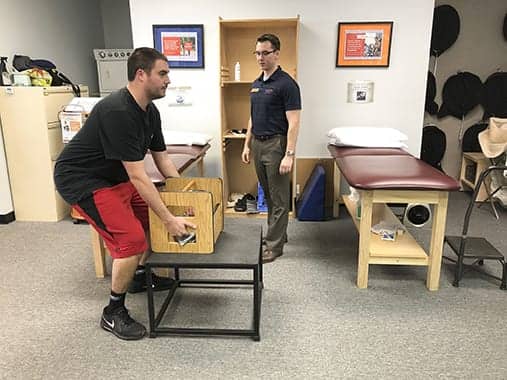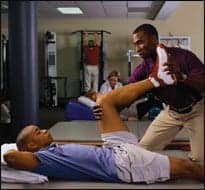
Marc Schoettle, PT, DPT, guides patient Mike through work simulation tasks as part of a work hardening and work conditioning program to help him recover from a lower back injury that occurred while on the job.
by Marc Schoettle, PT, DPT Let us face the facts. Injury to the musculoskeletal system is a leading cause for lost work days worldwide. Musculoskeletal injury is a category of injuries commonly diagnosed as muscle strains and sprains, degenerative joint and disc disease, bone fracture, and tendon tears. The World Health Organization (WHO) classifies more than 150 different diagnoses of musculoskeletal injury that are often progressive and affect millions of people globally.1 Not all of these conditions are created equal: some are acute and specific to a single event, while others can be chronic in nature and brought on by a more insidious and repetitive mechanism. No matter the type or cause of musculoskeletal injury, injuries account for a high percentage of lost work days. The WHO reports that in the United States, lower back pain has accounted for an estimated 50 million lost work days per year with typically 7 lost work days per episode of back pain.1 These lost work days have a high economic burden on individuals, families, workplaces, and government, costing an estimated 200 billion dollars per year. It is reported that eight out of 10 Americans will suffer from back pain at some point in their lives.1 Lower back pain affects many individuals and is the most common area of injury affecting the working individual. It is not, however, the only area affected. In a report published by the WHO in 2018, occupational risks were assessed and determined that of the leading musculoskeletal disorders, low back and neck injury account for approximately 20%, rheumatoid arthritis accounts for approximately 16%, and osteoarthritis can account for an estimate 20%.1
Cause of Conditions
Lower back and neck injuries are typically caused by an ergonomic stressor or stressors in which there is a breakdown in posture or body mechanics of an individual. People who are at greatest risk for lower back injury work in physically demanding fields; for example, they are manual laborers, construction and utility workers, and farmers and fishermen. Neck injuries are mostly commonly brought on by sedentary, faulty posture work positions possibly caused by a poor workstation setup. Osteoarthritis is likely brought on by material and non-material handling stressors such as heavy lifting, repetitive vibration, or repetitive kneeling and crawling.
Reducing Lost Work Days
We now understand that there are a few different categories of injury involving the musculoskeletal system which account for many lost work days impacting productivity and place a burden on the individual suffering from the injury and the economy. Let us now shift our focus to injury prevention and recovery, as there are several ways to reduce lost work days caused by injury. The number one focus should be on injury prevention. The 2018 WHO report on Preventing Disease Through a Healthier and Safer Workplace states that a workplace physical activity and intervention program has been shown to reduce injury costs to the employer and prevent injury to the worker.1 These programs can include employer-designated health screenings, workstation ergonomic assessments, and workday warm-up exercises. Additionally, some employers require pre-hire testing to determine an individual’s ability to perform the physical demands of the job. Physical therapists play a major role in workplace injury prevention. This is because, in many cases, a physical therapist is contracted by a company to perform ergonomic assessments and training as well as perform the pre-hire physical testing. Though it would be nice if proactive and preventative measures could completely rid the workplace of work-related injuries, in reality such measures do not accomplish this. In fact, workplace injury is prevalent and, therefore, effective treatments need to be available to the injured worker.
Treatment Approaches
In the United States, one of the first treatments for workplace injury is through use of medication and, if necessary, adjustment to the individual’s job duty levels. The individual may then be advised for treatment from ancillary services such as physical therapy. Physical therapy is one of the most effective resources to treat the injured worker and helps prevent lost work days. There are many mechanisms for which physical therapy can help the individual or patient reduce pain and restore functional strength and mobility. Modalities such as ultrasound and vasopneumatic compression devices are used for pain management and swelling control, manual techniques are used to restore joint and muscle function, and therapeutic and neuromuscular exercise/activity is used to improve motor control and sequence to restore efficient movement patterns and return full strength and range of motion. At initial evaluation, the patient undergoes a thorough examination of subjective and objective measures to determine the source of the patient’s primary complaint. Then the physical therapist assesses the data gathered at the evaluation and works with the patient and medical team to determine the best course of treatment to achieve both personal and work-related goals as related to the injury. Ideally, a patient’s course of care is complete once the injury stabilizes, which then allows them to return to work full duty. In many cases a patient is capable of working through the injury while undergoing treatment outside of work. In other cases, a patient is placed on medical leave or restricted in duty while undergoing treatment. In these instances, a patient may not be able to return to work full duty once the injury stabilizes. When this happens a patient likely would benefit from an industrial rehab program, more commonly a work hardening and work conditioning program.
Beyond the Numbers
Industrial rehab is an important component in returning injured patients to work because in many cases, an injury disrupts the individual’s ability to perform the stressors of his or her job. That individual is then at a higher risk of reinjury by returning to work without proper work hardening and work conditioning. Jim Mecham, a leading expert in industrial medicine, states that just because an individual has full mobility and strength following an injury does not mean that person is conditioned to return to full-duty work.2 These individuals run the risk of immediate reinjury. With traditional physical therapy treatments, an individual’s injury likely would recover to test 5/5 normal in strength and have functional measures for range of motion without pain, and on that premise be discharged to a home exercise program and cleared by a physician for return to full duty. Another approach, however, calls for a therapist to look beyond the numbers and recommend a functional capacity evaluation be performed to gather baseline measures for the individual’s ability to perform his or her job. If the return to work percentage is less than 100%, a work hardening/conditioning program would likely be recommended. Work hardening and work conditioning are provided by a skilled provider, often a physical therapist, credentialed to provide these services. When it is deemed that a patient’s injury is stable, that person is enrolled in the program and put through a functional evaluation that tests the current level of function compared to the required job demands for return to full duty. A treatment program is then established which involves exercises and activities specifically designed toward achieving the work-related non-material handling, material handling, and positional tolerance goals. A patient is typically enrolled in the program for greater than 2 hours a day and at times up to 5 days per week. The purpose is to progress the patient through the program and incrementally increase his or her workload back to the full-duty job demands.
Safe Return Case Study
Take for example Dave, a 35-year-old factory worker, who suffered a lower back injury when transferring a 100-pound pallet of material from a shin-high platform to a waist-high table. He was initially prescribed an anti-inflammatory medicine and instructed by his physician to undergo physical therapy. He was placed on light-duty desk work for 8 hours a day. To return to work full duty he must be able to stand for three quarters of his shift, occasionally power lift 100 pounds at least 50 times per day, and frequently push 25-pound boxes across a table during a typical shift. Dave underwent successful physical therapy treatment over a 4-week period while he was designated light-duty and performed a sedentary desk job. In order to safely return to work and minimize the risk of reinjury, Dave’s physical therapist recommended that he undergo a functional capacity evaluation (FCE) to assure that Dave is appropriate for a safe return to work. The FCE determined that Dave was 60% capable of full-duty work requirements. The physical therapist then recommended to Dave’s physician that he participate in an industrial rehabilitation work hardening/conditioning program to assure that Dave can withstand the rigors of the job, including heavy lifting and repetitive movements, before returning to work. The work hardening/conditioning program would educate Dave about proper lifting principles, assuring that he has proper body mechanics for the heavy lifts and frequent material pushing. Work simulation tasks would be initiated and progressed to assure that Dave can lift 100 pounds from his shins to a table and then push 25-pound boxes repeatedly across the table. He would build strength in his arms, trunk, and legs so that he can physically handle the stressors involved with these tasks. Dave would be discharged from this program once he is able to safely perform 100% of his full duty requirements.
The Data Points of Success
At the Physical Therapy and Wellness Institute (PTW), 96% of industrial rehab patients enrolled in the practice’s Work Ready Program return to work and remain healthy at work for at least 6 months upon completion of the program.3 Eighty-six percent of those patients return to work completely healthy. PTW’s work ready program is an intensive, work-related, goal-oriented conditioning program. It begins with a work-specific evaluation including systems review, selected tests and measures, and identification of the worker’s individual work-related restoration needs. Evaluation of examination data is used to identify eligibility, design a plan of care, monitor progress, and plan for discharge and return to work. Ultimately, an individual who successfully completes an industrial rehabilitation work hardening/conditioning program, such as PTW’s Work Ready program, is more likely to remain at work long-term following completion of the program. The program increases their work-specific conditioning, assuring the individual and the employer that they are safe to return to full duty. It should be every treatment provider and employer’s goal to safely return the individual to work which, in turn, reduces the negative impact of the injury on the economics of the injured worker and the workplace. RM Marc Schoettle, PT, DPT, is clinical supervisor at The Physical Therapy & Wellness Institute in West Norriton, Pa. He received his DPT degree from Temple University in Philadelphia. He utilizes an evidenced-based approach to treatment and performs various manual therapy techniques supported by the literature to optimize patient outcomes. Schoettle is a current member of the APTA. For more information, contact [email protected]. References 1. Wolf J, Prüss-Ustün A, Ivanov I, et al. Preventing disease through a healthier and safer workplace. Geneva: World Health Organization; 2018. License: CC BY-NC-SA 3.0 IGO. 2. Mecham J. Industrial Rehab 2020. Impact. July 2009:18-21. 3. Work Ready Program at PTW. 2019. Available at: https://ptwinstitute.com/occmed/




